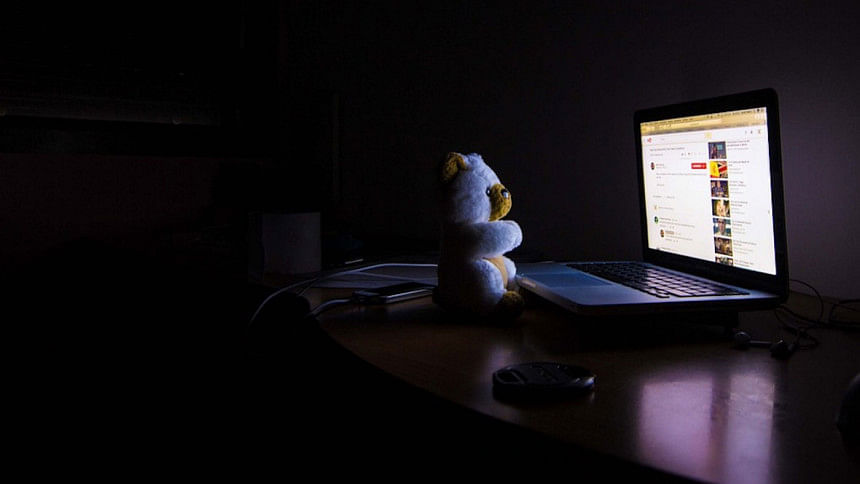Protecting children online and in the real world

Accor-ding to a report published in March 2021 by Ain o Salish Kendra (ASK), 30 percent of children have experienced various forms of online harassment during the Covid-19 pandemic. The study was conducted in five districts—Dhaka, Chattogram, Rajshahi, Cox's Bazar and Satkhira. Among the victims of harassment, 56.25 percent are girls. Forty-one percent of these children informed their parents about the harassment and 12 percent refused to talk about their experiences. Legal steps have been taken in only six percent of these cases.
According to a pre-pandemic survey of ASK published in early 2020, 8.39 percent of girl children had experienced online harassment. However, in 2021, this number increased by over four times. Globally, children are spending excessive amounts of time online during the pandemic, which has created concerns.
Children are one of the most significant users of the Internet for education, communication and entertainment. While there are many benefits, various new child protection risks have also emerged due to children's access to cyberspace. Violence and harm against children in the online world could present itself in many different forms. One of these is the production, distribution and use of materials depicting child sexual abuse. Online solicitation or "grooming" is another serious concern, where an abuser secures a child's trust in order to draw them into a situation where they may be harmed. Adult pornography exists in abundance on the Internet, which many children can access.
Moreover, information on tools for violence, cults, drugs etc. are freely available through the web, which could be very damaging for children. Cyberspace hosts a vast number of venues (chat rooms, message boards and games) where children congregate. This provides greater opportunities for abusers to seek out and approach children relatively easily, and eventually they can harm them psychologically and/or physically. Cyberbullying is also quite common.
It must be remembered that the abuse of a child is still more likely to occur within the family than anywhere else, but cyberspace opens up the possibility for family members to also use the technology abusively. Moreover, it provides other family members and strangers with the opportunity to contact children with whom they would not otherwise have had any kind of relationship.
Online sexual harassment and paedophilia are not properly addressed in the legal system of Bangladesh. For example, there is no specific legal provision on paedophilia in the Digital Security Act, 2018. Child pornography has been addressed in the Pornography Control Act, 2012. However, there is no provision for the cases where both perpetrators and victims are children.
Lack of awareness among parents and children in Bangladesh is a major reason behind the increase in child protection concerns online. In many cases, children do not share their experiences of harassment in fear of further punishment from their parents.
Many parents in our society do not have updated knowledge on technology and feel helpless in such situations. However, one does not have to be a technology expert to provide the appropriate guidance to children on protecting themselves in the virtual world. The Australian E-Safety Commissioner made some useful recommendations for parents so that they can ensure children are protected online, which are relevant for parents everywhere. These include: "build an open trusting relationship around technology; co-view and co-play with your child online; build good habits and help your child to develop digital intelligence and social and emotional skills; empower your child; use devices in open areas of the home; set time limits that balance time spent in front of screens with offline activities; know the apps, games and social media sites that your kids are using; check the privacy settings; use available technologies to set up parental controls on devices; be alert to signs of distress."
Online activities have their roots in offline behaviour, and it is important to understand the contexts in which the Internet is used, instead of just focusing on the technology itself. Some children are especially at risk due to a range of vulnerability-enhancing factors. If children live in socially and economically difficult conditions, have already experienced harm such as sexual abuse and exploitation, suffer from loneliness and low-esteem, and are alienated from parents and others, they are more likely to be negatively affected.
The principles of protecting children online and in real settings are quite similar. It is about effective parent-child communication. If parents spend quality time with children, listen to them actively and understand their lived realities including their interests, friends etc., they will be able to offer the right guidance and support as and when required.
Children are not homogeneous as a group—their vulnerabilities and capacities are different (based on their age, sex, sexual orientation, socioeconomic status, history of abuse, etc). Some of them are aware of the risks and adopt self-protection mechanisms, while some do not. Parents, teachers and caregivers should support the children by making them aware of child protection issues and educating them on how they can use the Internet to enhance the quality of their lives.
We need a multi-sectoral response to protect children in cyberspace. The government should develop and implement policies on awareness raising, rehabilitation services, industry accountability, research, etc. Online child harassment cases should be tried under cybercrime tribunals. There is a need to harmonise relevant laws such as The Children Act, 2013 (amended 2018), Information and Communication Technology or ICT Act, 2006 (amended 2013), and The Pornography Control Act, 2012 to prevent online violence against children. Under government leadership, the ICT industry (Internet service providers, mobile phone companies, etc.) should participate in ensuring that the rights of children are internalised in the development of their products and services. The capacity of members of law enforcement agencies should be developed to collect digital evidence and they should learn to be child sensitive.
There is a need to achieve a balance between utilisation of the positive aspects of the cyber world—ensuring the rights of children to privacy, information, expression and association—and protecting them from abuse. It is our responsibility to ensure that using the Internet becomes an empowering experience for children.
Laila Khondkar is an international development worker.

 For all latest news, follow The Daily Star's Google News channel.
For all latest news, follow The Daily Star's Google News channel. 



Comments